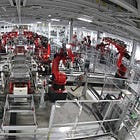|
 |
During the Biden years, there seemed to be an emerging bipartisan consensus that America needed to build more. On the left, you had the rise of industrial policy — Biden literally called the initial version of the Inflation Reduction Act the “Build Back Better” bill — and the nationalization of the YIMBY movement. On the right, you had Marc Andreessen writing an essay called “It’s Time to Build” — basically advocating that the government get out of the way of the private sector — and you also had a bunch of people starting defense tech companies. The bipartisanship even made it into legislation — Biden’s Infrastructure Investment and Jobs Act and the CHIPS Act were both passed with significant Republican support.
To document the spirit of the times, I wrote two “roundup” posts — one in 2022, the other in 2024:
This enthusiasm for rebuilding America came in the wake of two destructive crises — the financial crisis and Great Recession of 2008-11, and the Covid shock of 2020. I would argue that it was also a response to the social unrest of the 2010s, which pitted Americans against their neighbors in a destructive, bitter status conflict. I think the idea of rebuilding America had bipartisan appeal in part because it felt like an alternative to focusing on intractable cultural differences — a way of moving up and forward, instead of left or right.
All of this seemed to fulfill the predictions of the 1997 book The Fourth Turning, in which William Strauss and Neil Howe predicted that a crisis would lead to a general awakening in the 2020s in which the generation that we now call Gen Z would build new national institutions and usher in a new spirit of community and collective effort.
The Biden administration was, at best, an imperfect avatar of this national impulse. Although it had some promising successes, the progressive instinct for proceduralism and the influence of entrenched special interests hobbled many of its initiatives. And socially, America remained bitter and divided — contra to the predictions of Strauss and Howe, the ebbing of unrest was due more to exhaustion than to the victory of one side. We were building chip factories, but we weren’t yet building a shared national culture or functional community institutions.
When Trump was elected last year, there was a brief moment when some people thought the Fourth Turning was back on track. Trump’s margin of victory was slim, but he did win the popular vote and all the swing states. And the big shift of minority voters toward Trump seemed to promise a way out of the 2010s social division — a new conservative consensus that crossed racial lines. Trump had also added Elon Musk to his team, and the country’s most successful industrialist was promising to make government run more efficiently. Defense tech entrepreneurs were posting American flags on X, and there was also some hope that a wave of deregulation would unleash private-sector energies that Biden had struggled to harness.
Half a year later, it’s apparent that this is not what’s going to happen. We have now seen what the MAGA movement has planned for America, and it’s pure destruction.
First, Elon Musk’s Department of Government Efficiency turned out to be entirely an ideological purge rather than an attempt to make the government run more efficiently. Promises of trillions of dollars in savings dwindled to a mere $160 billion (and will likely dwindle even further), as Elon’s squad of young tech workers rediscovered the fact that the U.S. government is already a pretty bare-bones operation. Meanwhile the effort will cost an estimated $135 billion, basically eliminating all of the savings. And although not everything it’s doing is counterproductive, DOGE will probably leave a lasting negative impact on American state capacity.

